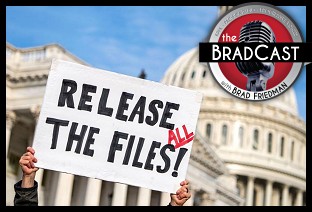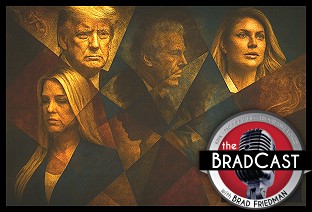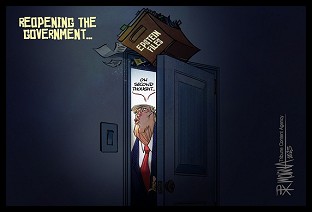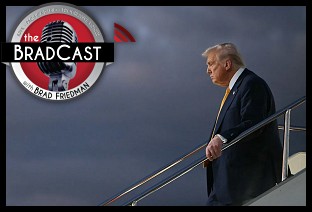 The Tampa Bay Scene cover story in their September 21, 2006 issue is a detailed report on the Tom Feeney / Clint Curtis / Yang Enterprises Inc. vote-rigging scandal. Their version of article is posted online in PDF format. The editors have granted us permission to post the entire story in plain HTML below.
The Tampa Bay Scene cover story in their September 21, 2006 issue is a detailed report on the Tom Feeney / Clint Curtis / Yang Enterprises Inc. vote-rigging scandal. Their version of article is posted online in PDF format. The editors have granted us permission to post the entire story in plain HTML below.
The BRAD BLOG discussed the new details which emerged from this particular coverage in an article here.
For those unfamiliar with the Feeney/Curtis story, a quick summary is here, along with a full index of the key articles in our two years-long investigation.
Clint Curtis (D) is currently running against Tom Feeney (R) for the U.S. House seat in Florida's 24th congressional district.
WARNING: The Scene's article includes some of the graphic photos related to the mysterious death of Raymond Lemme, the investigator from the Florida Inspector General's office who died just after purportedly telling Curtis he'd discovered the investigation "goes all the way to the top." Those extremely graphic photographs are included with detailed the story below!
###
SLINGIN' MUD
By Bill Stone (Bstone@tampabayscene.net)Originally published by Tampa Bay Scene - September 21, 2006. PDF version here.
In 2004 a computer programmer with Yang Enterprises (www.yangenterprises.com) of Oviedo, Florida testified before Members of the House Judiciary Committee that in 2000, Congressman Tom Feeney (R-Fl) asked him to develop a prototype of a voting program that could alter the vote tabulation in an election and be undetectable. The programmer, Clint Curtis, is a graduate of Illinois State University and also holds a degree in Political Science. Curtis was hired by Yang in 1998 and testified he became the firm's lead programmer. Curtis maintains he had daily meetings with Yang's CEO Mrs. Li Woan Yang and in the fall of 2000, met Feeney, future Speaker of the House of Representatives for Florida and legal counsel for Yang. Curtis gave a sworn affidavit detailing his allegations. What he had to say was chilling and if true, should jar the soul of every freedom-loving American. The following information is culled from Curtis' sworn affidavit, in addition several conversations with him over the past few weeks. Also instrumental in providing information for this article was Brad Friedman (www.bradblog.com), an investigative journalist and progressive blogger hailed by Air America and Rep. John Conyers. Friedman is diligently following Curtis' saga and has devoted countless hours over the years gathering much of the detailed information illustrated in this article.
Curtis testified Feeney was not only a lobbyist, but corporate counsel for Yang. Curtis says he met with Feeney "on dozens of occasions" and discussed the viability of several projects with him. Curtis says he became the technological consultant to Feeney concerning projects and Feeney would advise Yang Enterprises how to obtain contracts for the projects. Curtis testified that in October 2000 he attended a meeting at Yang Enterprises with Mrs. Yang, Mike Cohen (Mrs. Yang's executive assistant) and Feeney. Curtis maintains Feeney was extremely specific in his request for Yang to develop a program capable of altering vote counts. Curtis testified Feeney asked that the program be compatible with touch-screen technology, "the user be able to trigger the program without any additional equipment" and that the "programming to accomplish this remain hidden even if the source code was inspected." According to Curtis, he told Feeney it "would be virtually impossible to hide such code written to change the voting results if anyone were able to review the uncompiled source code." However, Curtis testified he remarked to Feeney that if the code was compiled prior to being reviewed by anyone, any vote fraud would remain undetected. Curtis says his initial impression of Feeney's interest in such a program was due to a concern that democrats would try to use such a program to steal an election. It should be noted at the time, Curtis was a life-long republican. The quotes below are attributed to Curtis' testimony unless otherwise noted.
Curtis maintains, "Mrs. Yang told Feeney the company would create the prototype for such a program and that he designed a software program where each candidate is represented as an element of an array of controls. Each candidate is listed in a database and their number corresponds to where you want them to show up in that array. When the program starts, it reads the database and takes the number assigned to the candidate and fills in the label with the index that matches the number. That allows the program to work dynamically. It doesn't matter who the candidate is as they have been equated to the index number assigned. From a normal perspective, it allows the voter to select the candidate, click on the submit button and the candidate's selected previous vote total is then increased by one. In the vote prototype I created, things were not what they seemed. Hidden on the screen were invisible buttons. A person with knowledge of the locations of those invisible buttons could use them to alter the votes of any candidate listed. By clicking the correct order of invisible buttons the candidate selected by the user is compared to other candidates within that same race. If the candidate they selected is leading the race, nothing happens. If the other candidate is leading the race, the vote totals are altered so that the selected candidate is now leading the race with 51% of the vote. The other candidates then share the remaining 49% in exact proportion to the totals they had previously. In the prototype to Feeney, the vote totals showed on the screen. In an actual application, the user would receive no visible clues to the fraud that had just occurred. Since the vote is applied by race, any single race or multiple races can be altered. The supervisors or any other voter would never notice this fraud since no visible sign would appear. Additionally, the procedure could be repeated as many times as was necessary to achieve the desired results. No amount of testing or simulations would expose the fraud as its activation and process is completely invisible to everyone except the person programming the vote fraud routine. The same procedure could be activated without any user intervention whenever the machine detects a certain pattern of voting. The algorithm could also be altered from hidden keys or triggers that would allow the fraudulent user to manipulate both the margins and percentages of any particular race. In most national elections, it is not necessary to win every area."
"Once I had the software program done, I wrote a report on how a person could see voting manipulation simply by looking at the source code. Any manipulation of the vote and the procedures for flipping the vote would be obvious to a competent programmer. I provided the program to Mr. Hai Lin Nee, the Quality Control person at Yang and discussed it with him. He approved its distribution. I gave the software program, which was on a CD disc, and the report that was on disc and paper to Mrs. Yang. I stressed that she and Mr. Feeney could view the operation of the program and then see how to detect such fraudulent source code so it could be prevented. Conversely, if they allowed blind (already compiled) code to be used (no source provided) and there were no paper receipts, the votes could be flipped from one candidate to the other without any possible way for the deception to be detected. I explained that this could be done with a touch screen machine or automatically. She (Mrs. Yang) immediately stated, "You don't understand, in order to get the contract we have to hide the manipulation in the source code. This program is needed to control the vote in south Florida." I was shocked that they were actually trying to steal the election and told her that neither I or anyone else could produce any such program. She stated that she would hand in what I had produced to Feeney and left the room with the software."
"In my role as a technology adviser at Yang, I was present at subsequent meetings between Mr. Feeney and Mrs. Yang. In several of those meetings, prior to the 2000 election, it became clear to me that Mr. Feeney was well aware that by artificially reducing the margin of victory of the opposition party in areas where they were the strongest, the overall outcome would then favor his candidate. As well, he bragged he had already implemented 'exclusion lists' to reduce the 'black vote'. He further mentioned that the 'proper placement of police patrols could further reduce the black vote by as much as 25%. I didn't know at the time if Mr. Feeney had meant that as a racial joke or actually part of the plan."
"Soon thereafter I resigned from Yang and took another job at the Florida Department of Transportation (FDOT). While there, I discovered some other illegal activities of Yang, who had contracts with FDOT, involving over-billing and defrauding of the State of Florida regarding contracts that I had worked on at Yang. I reported this information to the FDOT Inspector General's office and they began harassing me and another employee, Mavis Georgalis, who had made similar reports and eventually we were both fired by FDOT on the same day. We later filed whistle blower complaints against FDOT. Mrs. Georgalis was successful but mine was filed after the deadline and missed. The Inspector General at the FDOT, Raymond Lemme pursued some of the allegations I made against Yang, as I had advised him of the information concerning Tom Feeney and the vote fraud issue, illegal aliens employed by Yang, fallacious over-billing, and a wiretapping module that was placed into a FDOT software program for the document management system. Mr. Lemme continued to meet and talk with me about matters relating to the case after I was fired from FDOT, and in June of 2003, he told me that he had tracked the corruption "all the way to the top" and that the story would break in the next few weeks and I would be satisfied with the results. A few weeks later, on July 1, Mr. Lemme was found dead with his arm slashed in a hotel room in Valdosta, Georgia."
"Hai Lin Nee, the Quality Control Manager at Yang, also worked with a company called Azure Systems of Orlando. While working at Yang Enterprises, Mrs.Yang provided Mr. Nee with many gigabytes of downloaded information from NASA projects that Yang was working on, including the Maximo facilities repair maintenance database, which he took from the premises of Yang. This happened on several occasions. Also, I saw Mrs. Yang send a great deal of internal information to her brother in China, who, she had informed me, had been deported for spying. Wayne Leaders, an investigator for NASA, later confirmed this deportation of Mrs. Yang's brother. Mr. Leaders was responding to one of my multiple attempts to contact NASA on the Yang matter. I had also made a report to Mr. Leaders regarding a program I had written for FDOT that allowed outside contractors to submit documents to FDOT. Between the time I wrote the program and the phase of Mr. Nee's quality assurance, I discovered that Mr. Nee had inserted a wiretapping module into the software that copied all the information bound to FDOT and sent it via the Internet to Yang. I have reason to believe he also did this with a similar program I had written for NASA. In late 2003 or early 2004, I provided information to Detective Rob Pace of the Leon County Terrorist Task Force concerning Hai Lin Nee who I had learned was an illegal Chinese alien. I informed Detective Pace that Mr. Nee was working at Yang on NASA programs. Hai Lin Nee was subsequently arrested by federal officials in Orlando, Florida on or about March 17, 2004 on charges that included sending radar guidance system chips for Hellfire Anti-Tank Missiles to a company in Communist China. In a plea agreement in July 2004, Nee stated "he had only sent parts out of the country ten to twenty times" in the last year. He pleaded guilty to one of three counts of attempting to export restricted items to the People's Republic of China in March 2004."
Nee was sentenced on October 7, 2004 by U.S. District Judge Gregory A. Presenell to three years of supervised probation and $100 fine. An illegal Chinese alien admitting to what is paramount to corporate if not treasonable espionage, and the guy gets a slap on the wrist.
What's wrong with this picture?
Curtis’ affidavit continues with, "I reported much of this information to the FBI, CIA, Homeland Security and Florida Department of Law Enforcement through emails but the only one to respond was Tom Yowell, a Special Agent with the Florida Department of Law Enforcement assigned to the FBI Joint Terrorism Task Force. Mr. Yowell responded via email on November 22, 2004, that Yang was under investigation by another office of the FBI and that if I supplied him with my telephone number and name, he would pass that information to the other office so that they could contact me. I did, but I have not yet heard back from the FBI or Mr. Yowell as of today's date. I have filed a QUITAM, which is still pending, with the state of Florida concerning the over-billing by Yang."
The Scene recently received a call from a source claiming he had information regarding a political celebration for newly elected Councilman Keith Britton at Toucan Willie's in Oviedo of which Feeney also attended. The source claimed Feeney was inebriated and began attacking the "dumb-ass Chronicle" for reporting Curtis’ allegations. Feeney allegedly began to speak of how he is "going after Curtis." Informed Seminole Chronicle Managing Editor Alex Babcock was in attendance, I contacted him for comment. Babcock confirmed Feeney's presence at the establishment and said the Congressman "was in good spirits that Curtis won." Babcock, asked if Feeney appeared drunk, said he had no such indication but confirmed a drink in the Congressman's hand during a conversation between the two. Babcock said Feeney was asked by a Chronicle reporter about a mailer appearing to flatter Curtis which Feeney's campaign recently sent to democrats. "He immediately talked about what he was going to do to him, said he was going after him," said Babcock. Babcock also confirmed the Chronicle's receiving a threat of litigation from Feeney's attorneys regarding the paper's publishing of Curtis' testimony and allegations.
Feeney maintains Curtis is crazy. The term "tin foil hats" is being regurgitated so many times by the Feeney camp, the term appears to be among their favorite new buzz words when referring to Curtis. In fact, for a Congressman who largely ignored Curtis over the last several years, Feeney recently produced a book addressing Curtis, according to Feeney campaign Spokesperson Pepper Pennington. Such an approach is favored by Republican consultant Tony Fabrizio who once said, "If you don't want to focus on your own record, you focus on the other guy's."
As recently as September 7, the Chronicle, in a column titled, "Feeney: Conspiracy man following my plan," wrote "Feeney used an obscenity to describe the Chronicle for publishing a story in December 2004 about Curtis claims."
Captain Brian Childress of the Valdosta (Georgia) Police Department was contacted for comment regarding discrepancies in the department's police reports involving the death of Raymond Lemme. Childress was first asked about photos that were never to have existed. Valdosta Detective Shannon Floyd's police report refers to "a defect in the camera flash memory cards resulted in no usable photography. Photographs will not be submitted with this report." Insider-Magazine, however, later published photos of the crime scene. Childress confirmed the authenticity of the photos and added, "Dumb luck on this case. (At first) we could not retrieve the memory disc on the camera. We found software to retrieve it." Childress referred specifically to a "disc" but Floyd's report refers to "memory cards." Note the use of plurality. Do or did multiple memory cards exist? Does Floyd's statement in her report not imply more than one card was used? And if such is the case, is she inferring both cards were rendered inoperable because of a malfunctioning flash? Childress was asked about what appear to be bruises on the right side of Lemme's neck in photos taken at the scene of his death. Childress lamented one of the photos was retouched and posted to the Internet. Childress was asked about the unretouched photos appearing to illustrate unmistakable bruising on the neck of Lemme. Childress said, "The crime scene technician who took the pictures was asked about that claim and says what is seen in the photo can be attributed to shadows." Childress was also asked about conflicting times and dates as illustrated on Lemme's registration slips at the motel. Childress said this too was investigated "and the official explanation is the hotel was in error."
Brad Friedman obtained copies of not one, but two different motel receipts from the Valdosta Knights Inn on Hill Ave. where Lemme’s fully clothed body was discovered in the room's bathtub. The first receipt is dated June 29, 2003 at 6:44pm and the Valdosta Police Department refers to this as the check-in receipt. The second receipt, dated June 30, 2003, appears to be a credit card check-out receipt and is signed "Raymond Lemme." According to Friedman, Lemme was not even reported missing until June 30. Mary Ann Lemme, Raymond's wife, wrote in a sworn affidavit to the State of Florida, Leon County, (case #03-109927) dated June 30, "I have been unable to reach my husband, Raymond, all day. He left work early this morning, approximately 5:15am, told me he loved me and that he would call me later. He had a meeting @ work today and I had been unable to contact him. When I got home @ approx 6:45pm, there was a message on his phone from his boss, Bob Clift, left @ approx 4pm, checking on him since he had not heard from him since he left a short message on his phone this a.m @ approx. 6:15 saying that he would be late because he said somethings come up & he would call later. This all is very out of character and he has never done this in the past. He is a cardiac patient and I am very concerned for his health."
Finally, Childress was asked why Floyd's police report indicates "no blood on towel" when a photo of the crime scene clearly indicates blood on a towel on which a man's dress belt rests. Childress said he wasn't sure and would obtain the case file and call me back later in the day, which did not occur. Subsequent calls to Childress were ignored.
Many questions remain unanswered. The original official police version would have one believe Lemme drove to Georgia on June 29, rented the room, drove the eighty miles back to his home in Tallahassee, spent the night with his wife, woke up the morning of June 30, drove back to his rented motel room in Valdosta, and killed himself. The check-out slip from the motel dated June 30 illustrates a check-out time of 6:54am, although an unsigned suicide note, purportedly written by Lemme, illustrates a time of 8:10am written in the upper right-hand corner. His body was
found July 1.Brad Friedman said the Valdosta Police Department, specifically Childress, responded to his inquiries in the same manner as how he responded to mine: multiple promises to call back which never occur, despite several additional calls left on his voice mail. Childress' reluctance in speaking to the press and addressing multiple but specific inconsistencies does nothing to lend credibility to the Valdosta Police Department's official version of events surrounding Lemme's death. If the inconsistencies can be chalked up to shoddy and/or botched police work, one can understand Childress' reluctance to admit such. One can also understand a law enforcement agency not commenting on open cases, but this case is officially closed and chalked up as a suicide, so why the runaround and secrecy by Childress and the Valdosta Police Department? The truth regarding mysterious circumstances and unanswered questions surrounding Lemme’s death remains buried and the Valdosta Police Department is partially to blame.
Clint Curtis took a polygraph test on March 3, 2005 administered by Tim Robinson, the retired chief polygraph operator for the Florida Department of Law Enforcement. Curtis was asked about his allegations concerning Feeney and vote-rigging software. Curtis passed the lie-detector test. Since then, Curtis has challenged Feeney on numerous occasions to also submit to a polygraph test.
Staff writer James Miller of the Daytona Beach NewsJournal-online reported September 7, 2006 about the confusion the touch-screen voting machines are causing in Florida regarding voter results. Miller indicated Volusia County experienced a problem he described as "results showing up as complete weren't necessarily so." Miller wrote, "Precincts were indicated as 100 percent complete because results from either the touch-screen or the paper-ballot machines --- but not necessarily both --- had been uploaded by computer to elections headquarters." Miller quoted Supervisor of Elections Ann McFall blaming "a software problem without a simple solution." Flagler County reportedly experienced similar problems.
www.beyonddelay.org is a Web site listing what it maintains are the most corrupt members of Congress. Number three on the list is Rep. Tom Feeney (R-Fl.) The site blasts Feeney for "three trips he has taken in apparent violation of House and travel gift rules." The site claims Feeney traveled to Scotland to play golf in August of 2003. Feeney initially claimed the cost of the trip was paid for by the National Center for Public Policy Research but the organization denied his claim. Upon "investigating", Feeney claimed to have discovered the bill of $5,643 was actually paid for by lobbyist Jack Abramoff. Feeney maintains he was lied to and misled about who actually paid for the trip.
The site also maintains Feeney took a trip to South Korea sponsored by the Korea-U.S. Exchange Council (KORUSEC) in violation of House rules which state, "..a Member, officer or employee may not accept travel expenses from a registered lobbyist or agent of a foreign principal." KORUSEC is registered with the Department of Justice under the Foreign Agents Registration Act and beyonddelay.org maintains Feeney has yet to file travel disclosure forms for the trip as stipulated as per House rules. Finally, the site mentions Feeney's trip to West Palm Beach with his wife, also taken in 2003. The information illustrates Feeney submitted a travel disclosure form to the House Clerk's office detailing expenses of the trip ($1430) paid for by Rotterman and Associates, a lobbying firm at the time. To reiterate, travel rules provide "..a Member may NOT accept travel expenses from a registered lobbyist." Inquiries by reporters in 2005 resulted in Feeney filing an additional amended disclosure form. This second form indicates the Center for the Study of Popular Culture paid for the Palm Beach trip.
Feeney campaign Spokesperson Pepper Pennington was contacted and inquiries were referred to Shannon Corrado. Corrado was asked to obtain comment from Feeney regarding Curtis' allegations and challenge to submit to a lie-detector test, in addition to Feeney's past statements claiming he never met Curtis.
Corrado sent the following response: "Representative Feeney is focused on having a reality-based discussion with voters on the issues he has fought for, such as eliminating wasteful government spending and Social Security reform that both protects seniors and provides a viable option for younger workers. Representative Feeney does not remember ever meeting Mr. Curtis, but, like most stalkers, Clint Curtis believes that he knows Mr. Feeney well."
Curtis says he never claimed or insinuated "he knows Mr. Feeney well."
Corrado was again contacted and asked to address the lie-detector issue. She sent the same response a second time.
Feeney's most recent face-to-face with Curtis occurred at an event held at a north Brevard Republican Women's Club. Club Vice-President Shirley Phipps and her husband Donald each confirmed both men were in attendance. Shirley Phipps said, "Curtis and his entourage showed up and Tom (Feeney) got up and said his opponent was in attendance." Phipps maintains it was a public meeting for listeners but not speakers and that Curtis and company left in a "huff" when informed they could not speak.
On September 5, 2006 in U.S. House District 24, Clint Curtis defeated Andy Michaud in his quest to face Feeney in the upcoming November election.
The Clint Curtis/Tom Feeney/Yang Enterprises Vote-Rigging Scandal series, please see:
- A Quick Summary of the story so far.
- An Index of all the Key Articles & Evidence in the series so far.
- Curtis is now running for U.S. Congress against Feeney.
To support or for more info, see: www.ClintCurtis.com


 Sunday 'Leave 'em in Stitches' Toons
Sunday 'Leave 'em in Stitches' Toons President of United States Calls for Killing Democratic Officials: 'BradCast' 11/20/25
President of United States Calls for Killing Democratic Officials: 'BradCast' 11/20/25 'Green News Report' 11/20/25
'Green News Report' 11/20/25
 Is MAGA Finally Beginning to Fall Apart?: 'BradCast' 11/19/25
Is MAGA Finally Beginning to Fall Apart?: 'BradCast' 11/19/25 Trump's Terrible, Horrible,
Trump's Terrible, Horrible, 'Green News Report' 11/18/25
'Green News Report' 11/18/25 A Kaleidoscope of Trump Corruption: 'BradCast' 11/17/25
A Kaleidoscope of Trump Corruption: 'BradCast' 11/17/25  Sunday 'Back to Business' Toons
Sunday 'Back to Business' Toons Trump DOJ Takes Stand
Trump DOJ Takes Stand 'Green News Report' 11/13/25
'Green News Report' 11/13/25 Mamdani's 'Surprisingly Affordable' Afford-ability Agenda for NYC: 'BradCast' 11/12
Mamdani's 'Surprisingly Affordable' Afford-ability Agenda for NYC: 'BradCast' 11/12 After the Shutdown and Before the Next One: 'BradCast' 11/11/25
After the Shutdown and Before the Next One: 'BradCast' 11/11/25 'Green News Report' 11/11/25
'Green News Report' 11/11/25 Victories for Democracy in Election 2025; Also: 7 Dems, 1 Indie Vote to End Shutdown in Senate: 'BradCast' 11/10/25
Victories for Democracy in Election 2025; Also: 7 Dems, 1 Indie Vote to End Shutdown in Senate: 'BradCast' 11/10/25 Sunday 'Ass Kicking' Toons
Sunday 'Ass Kicking' Toons 'We Can See Light at the End of the Tunnel' After Election 2025: 'BradCast' 11/6/25
'We Can See Light at the End of the Tunnel' After Election 2025: 'BradCast' 11/6/25 'Green News Report' 11/6/25
'Green News Report' 11/6/25 BLUE WAVE! Dems Win Everything Everywhere All at Once: 'BradCast' 11/5/25
BLUE WAVE! Dems Win Everything Everywhere All at Once: 'BradCast' 11/5/25 Repub Thuggery As Americans Vote: 'BradCast' 11/4/25
Repub Thuggery As Americans Vote: 'BradCast' 11/4/25 Last Call(s) Before Election Day 2025: 'BradCast' 11/3/25
Last Call(s) Before Election Day 2025: 'BradCast' 11/3/25 A Pretty Weak 'Strongman': 'BradCast' 10/30/25
A Pretty Weak 'Strongman': 'BradCast' 10/30/25 Proposal for 'Politically Viable Wealth Tax' Takes Shape in CA: 'BradCast' 10/29
Proposal for 'Politically Viable Wealth Tax' Takes Shape in CA: 'BradCast' 10/29 Monster Storm, Endless Wars, Gamed Elections: 'BradCast' 10/28/25
Monster Storm, Endless Wars, Gamed Elections: 'BradCast' 10/28/25 Let's Play 'Who Wants to Be a U.S. Citizen?'!: 'BradCast' 10/27/25
Let's Play 'Who Wants to Be a U.S. Citizen?'!: 'BradCast' 10/27/25 Exiled NOAA Scientists Resurrect Critical Disaster Database: 'BradCast' 10/23/25
Exiled NOAA Scientists Resurrect Critical Disaster Database: 'BradCast' 10/23/25
 VA GOP VOTER REG FRAUDSTER OFF HOOK
VA GOP VOTER REG FRAUDSTER OFF HOOK Criminal GOP Voter Registration Fraud Probe Expanding in VA
Criminal GOP Voter Registration Fraud Probe Expanding in VA DOJ PROBE SOUGHT AFTER VA ARREST
DOJ PROBE SOUGHT AFTER VA ARREST Arrest in VA: GOP Voter Reg Scandal Widens
Arrest in VA: GOP Voter Reg Scandal Widens ALL TOGETHER: ROVE, SPROUL, KOCHS, RNC
ALL TOGETHER: ROVE, SPROUL, KOCHS, RNC LATimes: RNC's 'Fired' Sproul Working for Repubs in 'as Many as 30 States'
LATimes: RNC's 'Fired' Sproul Working for Repubs in 'as Many as 30 States' 'Fired' Sproul Group 'Cloned', Still Working for Republicans in At Least 10 States
'Fired' Sproul Group 'Cloned', Still Working for Republicans in At Least 10 States FINALLY: FOX ON GOP REG FRAUD SCANDAL
FINALLY: FOX ON GOP REG FRAUD SCANDAL COLORADO FOLLOWS FLORIDA WITH GOP CRIMINAL INVESTIGATION
COLORADO FOLLOWS FLORIDA WITH GOP CRIMINAL INVESTIGATION CRIMINAL PROBE LAUNCHED INTO GOP VOTER REGISTRATION FRAUD SCANDAL IN FL
CRIMINAL PROBE LAUNCHED INTO GOP VOTER REGISTRATION FRAUD SCANDAL IN FL Brad Breaks PA Photo ID & GOP Registration Fraud Scandal News on Hartmann TV
Brad Breaks PA Photo ID & GOP Registration Fraud Scandal News on Hartmann TV  CAUGHT ON TAPE: COORDINATED NATIONWIDE GOP VOTER REG SCAM
CAUGHT ON TAPE: COORDINATED NATIONWIDE GOP VOTER REG SCAM CRIMINAL ELECTION FRAUD COMPLAINT FILED AGAINST GOP 'FRAUD' FIRM
CRIMINAL ELECTION FRAUD COMPLAINT FILED AGAINST GOP 'FRAUD' FIRM RICK SCOTT GETS ROLLED IN GOP REGISTRATION FRAUD SCANDAL
RICK SCOTT GETS ROLLED IN GOP REGISTRATION FRAUD SCANDAL VIDEO: Brad Breaks GOP Reg Fraud Scandal on Hartmann TV
VIDEO: Brad Breaks GOP Reg Fraud Scandal on Hartmann TV RNC FIRES NATIONAL VOTER REGISTRATION FIRM FOR FRAUD
RNC FIRES NATIONAL VOTER REGISTRATION FIRM FOR FRAUD EXCLUSIVE: Intvw w/ FL Official Who First Discovered GOP Reg Fraud
EXCLUSIVE: Intvw w/ FL Official Who First Discovered GOP Reg Fraud GOP REGISTRATION FRAUD FOUND IN FL
GOP REGISTRATION FRAUD FOUND IN FL
































